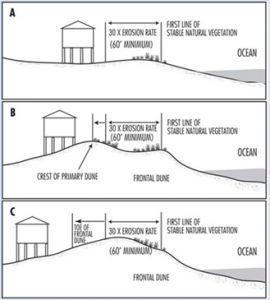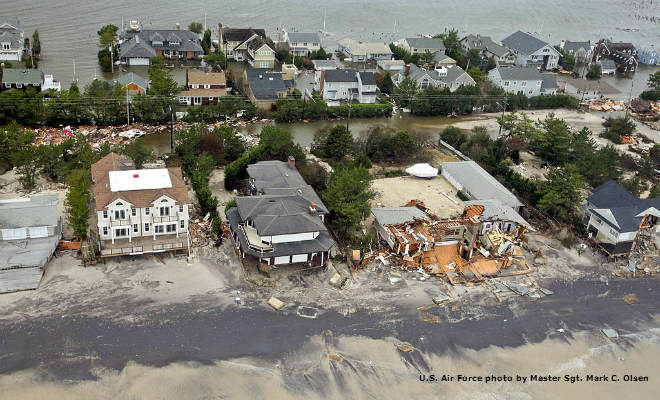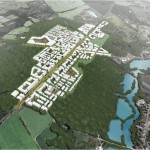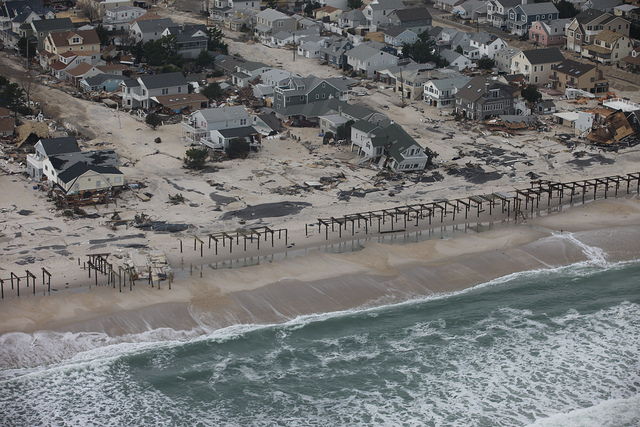New Jersey Future Blog
Planning for Sea-Level Rise IV: Changes to Building and Site Standards
February 8th, 2017 by New Jersey Future staff
This series of articles was written by New Jersey Future intern Connor Montferrat.
This is the fourth of a series of posts that will examine strategies being used in states throughout the country to reshape development patterns in response to risks posed by rising sea levels and a changing climate. The objective of the series is to present practical and tested adaptation and mitigation approaches that New Jersey communities might use to help respond to the growing threat presented by our subsiding and eroding coastlines, increasingly frequent and severe storms, and mounting flood risks.
This article considers changes to building and site standards to address risk.
Approaches
- Ingress/Egress Above Base Flood Elevation (BFE): In this approach, parcel access must exceed the BFE and must not be hindered by predicted sea level rise (SLR) or storm surge within the development’s anticipated life cycle. A BFE is a flood level that has a 1-percent chance of being equaled or exceeded in any given year.
- Increased Freeboard Requirements: Freeboard is any extra elevation above the BFE that yields a margin of safety from floodwater, floodway conditions, and wave action. The National Flood Insurance Program does not require freeboard, but adding height above the minimum NFIP requirements may reduce insurance premiums. Communities could increase freeboard consistent with projected SLR estimates and require site surveys to confirm pre-construction elevations. Freeboard requirements should match or exceed freeboard guidance under Executive Order 13690, which calls for two feet for non-critical structures and three feet for all critical structures.
- Increasing setbacks shifts coastal development or rebuilding inland as sea levels rise or erosion occurs, allowing for marsh migration, providing a consistent buffer against frequent tidal flooding, and allowing protection measures to move inland. Typically, a setback is the distance a building or structure is located from a curb, property line, or other protected land use. In the context of this definition, a setback is the undisturbed area between the waterline and building line.
- Limiting building size, height, density and type in zones that face frequent tidal inundation or severe threat from wave heights and storm surge helps to reduce exposure. One example would be restricting new buildings in these zones to temporary or portable structures that can be moved during evacuation events.
Examples in Current Use
- Ingress/Egress Above BFE
- Bridgeport, Michigan, requires plan and site inspection reviews of development by public officials to confirm proper emergency access.
- Salida, Colorado, requires that new critical facilities have continuous non-inundated access (ingress and egress for evacuation and emergency services) during a 100-year flood event.
- Increased Freeboard Requirements
- In Massachusetts and Virginia, elevating one to three feet above NFIP minimum height requirements has resulted in substantial reductions in flood insurance premiums while protecting property owners from future coastal storms.
- In Connecticut, the Town of Old Saybrook requires new critical facilities to be elevated or dry flood-proofed to at least one foot above BFE.
- Section 17.11.179 of the Annapolis, Maryland, Building and Construction code establishes a of two-foot freeboard above BFE as a factor of safety that compensates for uncertainty that could contribute to flood heights greater than the height calculated for a selected size flood and floodway conditions, such as wave action, obstructed bridge openings, debris and ice jams.
- Increased setback
- California has local coastal programs that establish buffer areas for new development that protect coastal waters, wetlands, and environmentally sensitive areas. For example, in Sand City, a setback from Monterey Bay is required for all new development in order to create a safety buffer consisting of a natural vegetative or contour strip. This buffer is designated according to the flood-related erosion hazard and erosion rate, in relation to the anticipated 50-year economic life of structures, and its specifications depend upon the geologic, hydrologic, and topographic characteristics of the land.
- In Maine, no building is allowed within 25 feet of the shoreline, except for water-dependent uses in general development zones. In resource protection zones, development is strictly limited to the upland edge of a wetland within 250 feet of the shoreline. Finally, structures greater than 2,500 square feet must be set back a distance calculated based upon the future shoreline position considering two feet of sea level rise over the next 100 years.
- Maryland requires that new development adjacent to the Chesapeake Bay include a 100-foot buffer measured inland from the edge of wetlands, shores, or streams. The buffer also includes contiguous sensitive areas such as steep slopes, hydric soils and highly erodible soils.
- Limiting building size/height/density
- Maine prohibits new buildings greater than 35 feet in height or with a footprint greater than 2,500 square feet within the coastal dune system unless an applicant can demonstrate that the site will be stable with two feet of sea-level rise over 100 years and the height will not affect existing uses including vegetation. Evidence of a seawall is not enough.
Relative to techniques described in prior articles in this series, such as density transfer, changes in building siting and design standards are straightforward, simple to administer and can reduce flood exposure considerably.

















